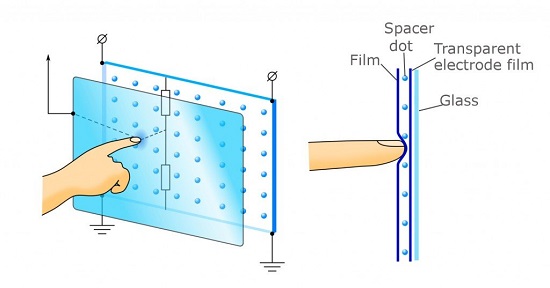Resistive Touch Screen Benefits
Resistive touch screen was first invented by Dr. Samuel G. Hurst in 1971. He called the sensor Elograph, after his company Elographics.
What is resistive touch?
As the name suggests, resistive touch LCD screen works on the basis of a pressure applied to LCD screen. A resistive touchscreen consists of several thin layers. The layers comprise of a bottom glass panel that is followed by two resistive circuit layers which are coated with electrically conductive thin metallic layers (e.g. ITO) separated by a slim gap consisting of spacer dots.

When pressure is applied on the screen with a finger or stylus, the outer resistive layer is pushed onto the inner layer. The two metallic conductive layers come into contact, causing a current loop and generating a change in resistance on both vertical and horizontal axis. The change is detected by the sensors located on the screen's edges which in turn find out the exact location by using the horizontal-vertical coordinates to indicate the touch point.
Benefits of resistive touch
- Minimal production cost - resistive touchscreens are easier to make due to its simple structure and cost less when compared with other LCD touch technologies.
- Activate with any object - as stated above, anything that can apply pressure on resistive touch screen will trigger a touch action and detected by resistive touch sensors. This property makes resistive touch screen the preferred choice in industrial and medical settings, where operators may use gloves on the LCD touch screen.
- Less sensitive to stray stimuli - how a touch action is detected by resistive touch screen determines liquid spills/snow or surface contaminants won't cause the touch screen to react unintentionally. And this is very important for industrial and outdoor environments.
- No shattered glass risk - most LCD touch screen technologies use glass as outer touch layer. This is usually not allowed in food and beverage facilities, to avoid shattered glass contamination. Resistive touch screen uses a tough polycarbonate outer layer, which can contain shattered glass in case the LCD screen is cracked.
- Low power consumption - resistive touch screen does not use much power.
- Not sensitive to EMI/RFI - resistive touch screen detects resistance change to locate touched coordinates. This is not suspective to EMI & RFI.
Resistive touch LCD screens have been used widely for many years. It is a well-proven and trusted solution for building human-machine interface. Here is an example of "How to implement LCD display resistive touch".
